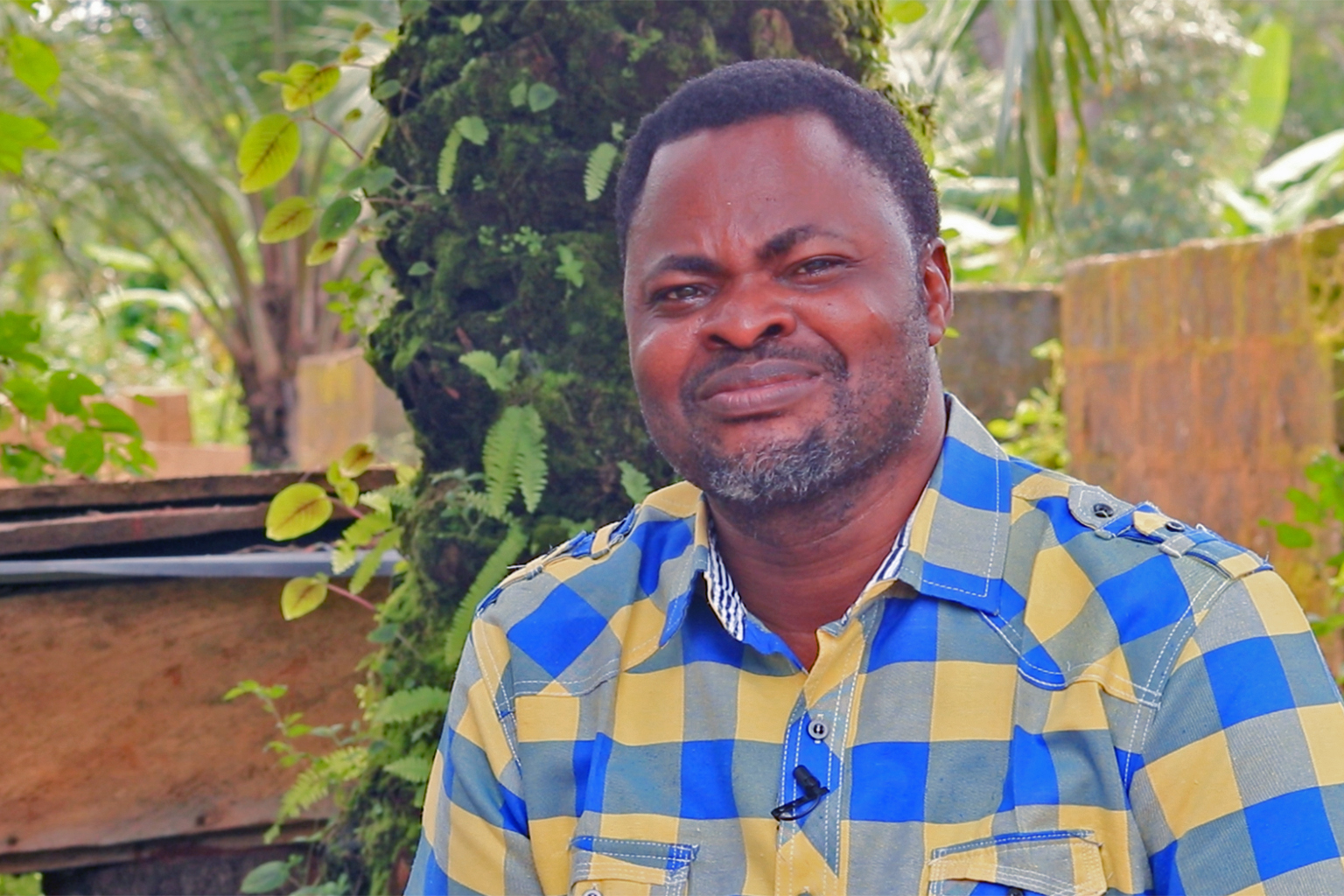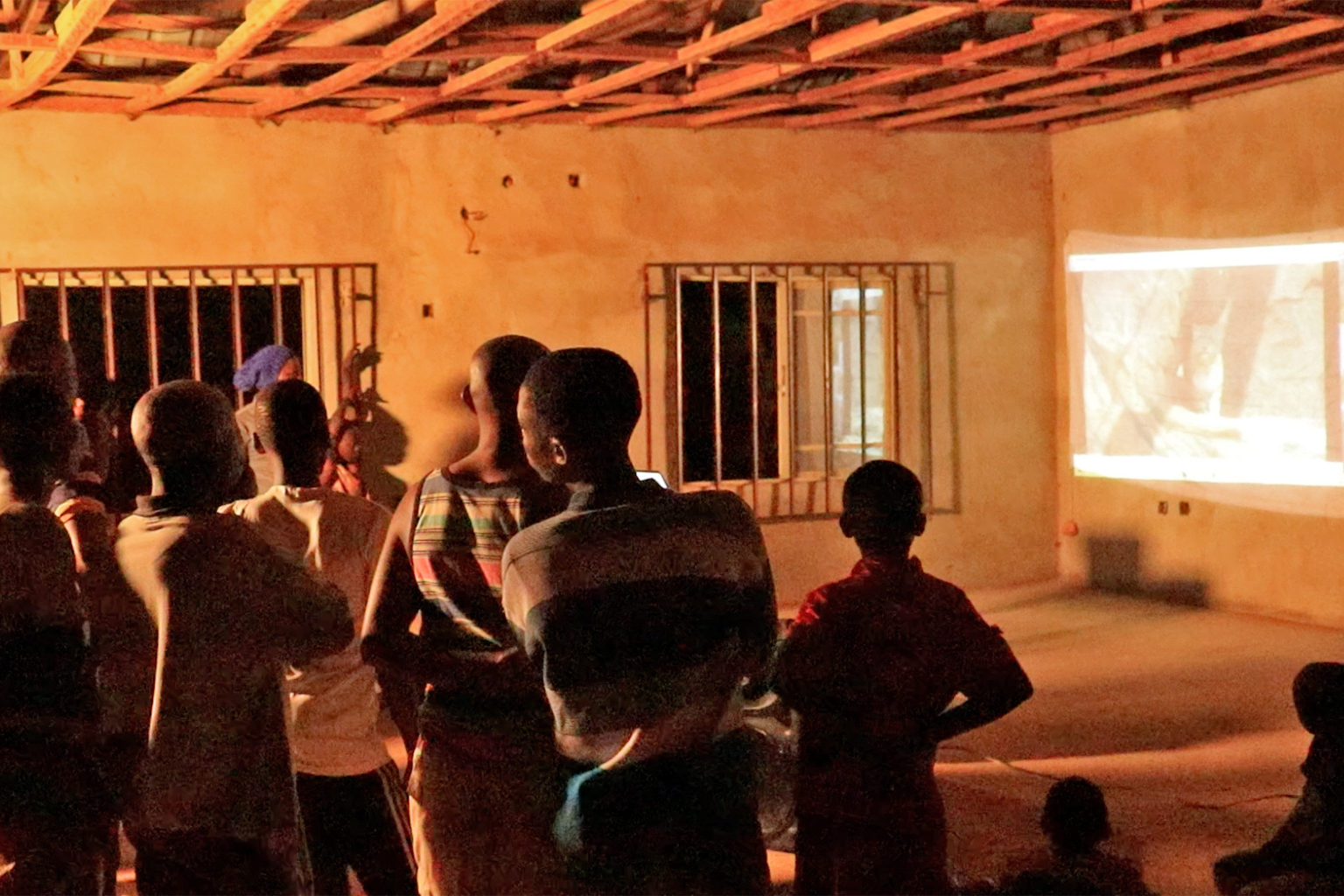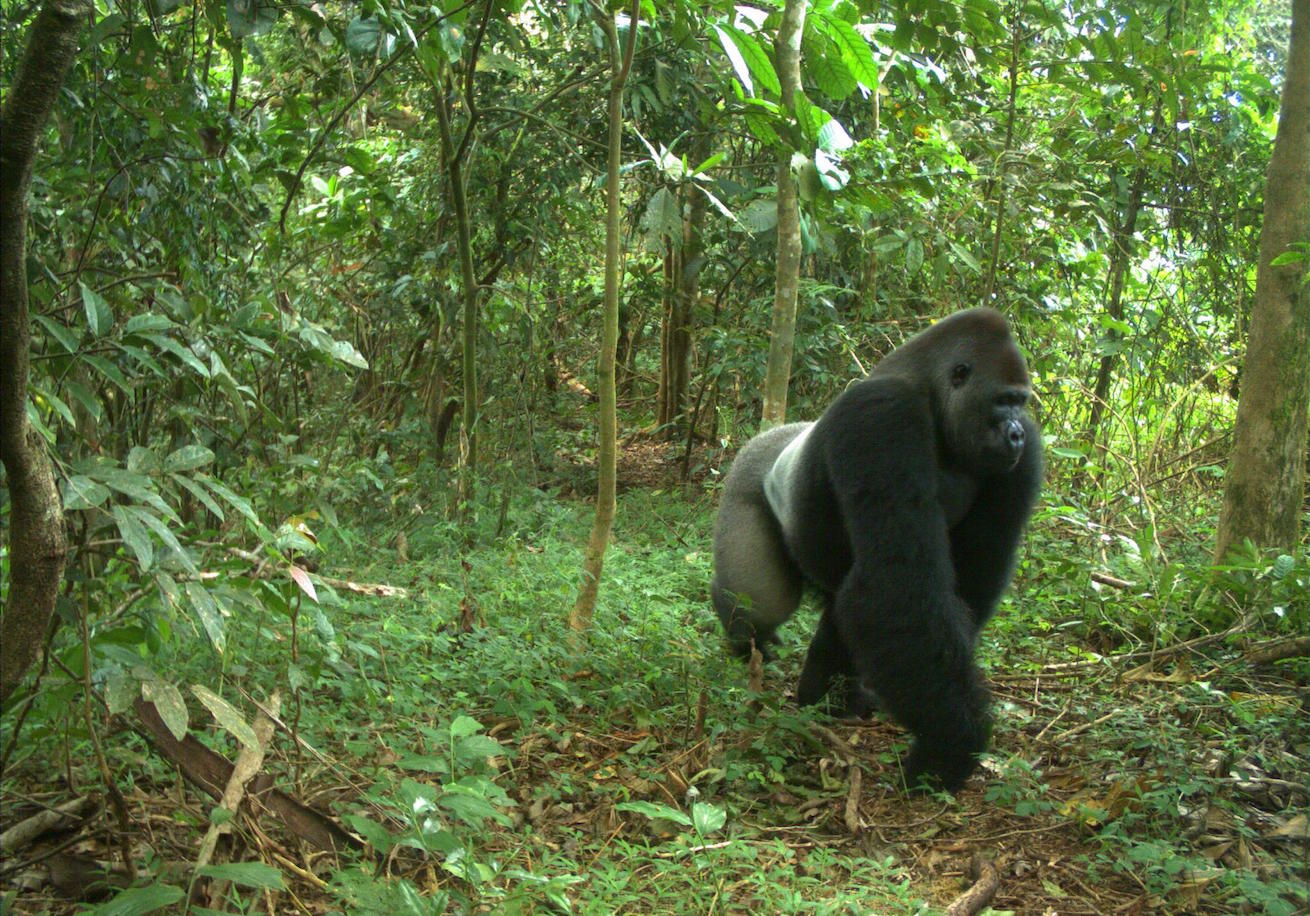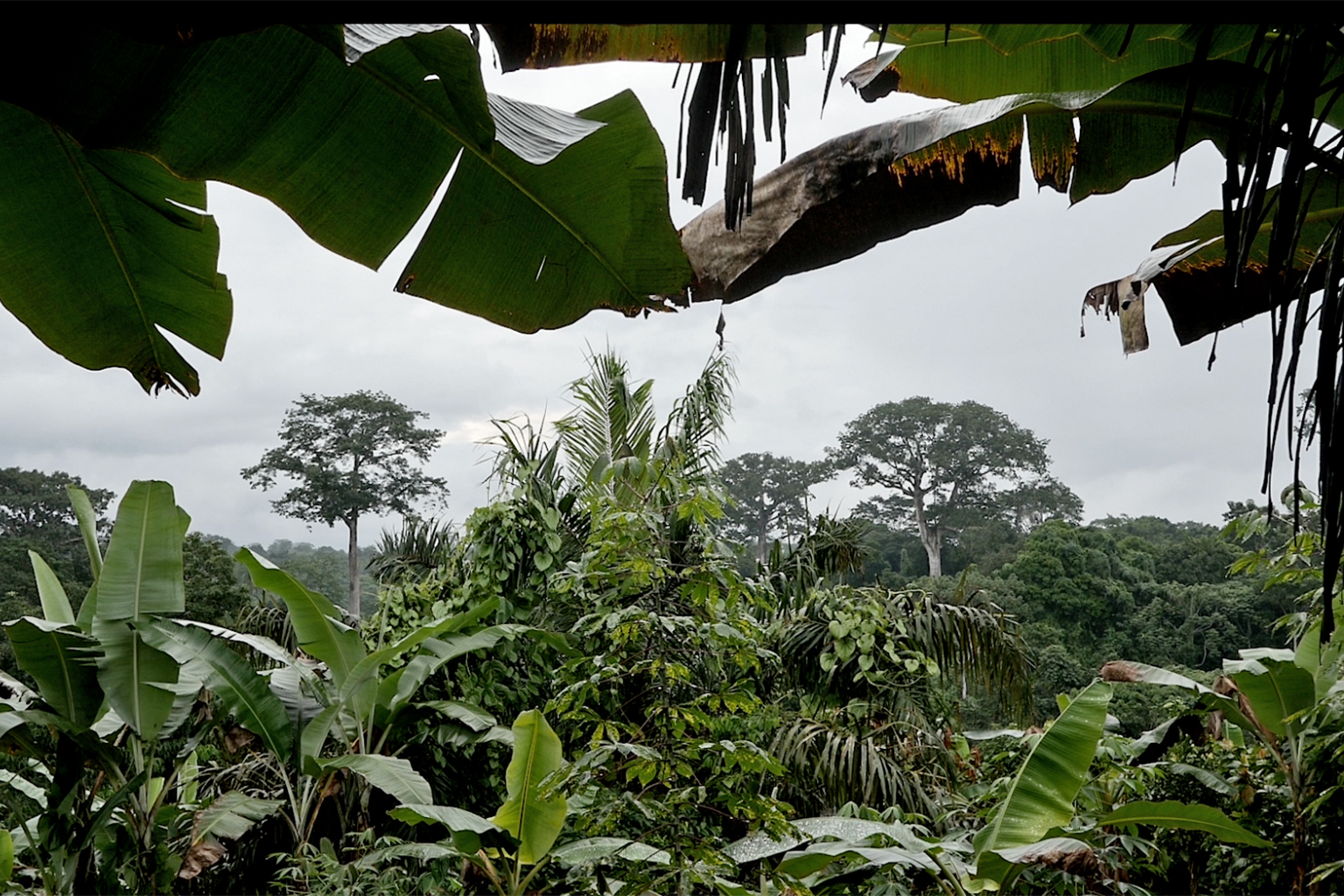In rural Nigeria, the magic of cinema builds support for ape conservation
Nov 15, 2021
- Since 2006, the Wildlife Conservation Society (WCS) has worked with local groups to screen documentaries about apes in dozens of communities adjoining protected areas where Cross River gorillas are still found.
- The films aim to build knowledge about apes and support for conservation; conservationists say film screenings, which are still a novelty in rural areas, attract a broader audience than radio shows, town hall meetings or other outreach methods.
- Though they live close to ape habitats, for many people in these rural communities, films are as close as they will come to encountering the rare and cryptic animals that live nearby.
BAMBA, Nigeria — It’s sunset in Bamba, a small farming community in Cross River state in southeast Nigeria. Louis Nkonyu, 46, caresses the touchpad of his laptop in search of a wildlife movie for the night. His face is lit with sweat and the whitish radiance from the projector screen.
Children sit on the cement-plastered floor. Outside the hall, a small crowd leans on a wooden window frame, jostling for prime position to get a glimpse of the screen. “Good evening my people,” Nkonyu says. “Today we want to show you a movie about why we must protect our Cross River gorilla … The duty to keep the gorilla and other apes is ours. Thanks for coming and please feel free to ask questions.”
When at last the movie of chimpanzees swinging from tree to tree emerged on the screen, silence fell over the room, broken only by the echoes of the loudspeaker and the rattling of a nearby generator.
Each major scene and moment attracts an interpretation from Nkonyu, who switches back and forth between formal and Pidgin English.
“Chimpanzees are very intelligent, and you can see how it saved the baby,” he tells the crowd, explaining a scene where a female chimpanzee allowed her infant to cling to her fur as she scurried away from an aggressive troop.
The show this evening is part of a program running since 2006, in which the Wildlife Conservation Society (WCS) screens documentaries about apes in dozens of communities adjoining protected areas where an estimated 100 Cross River gorillas are found.

Africa’s most endangered ape, with an estimated population of just 300 individuals, the Cross River gorilla (Gorilla gorilla diehli) is found in Nigeria’s Afi Mountain Wildlife Sanctuary, Mbe Mountains Community Sanctuary and the Okwangwo division of Cross River National Park as well as in protected sites in neighboring Cameroon.
The films focus on the life of great apes, their ecology, feeding habits, reproduction, conservation and the threats facing them, such as hunting, habitat loss and the bushmeat trade. The film complements other educational programs such as a weekly radio show, nature clubs for schoolchildren, field trips, town hall meetings and exchange visits to educate people about wildlife. These activities are all facilitated by WCS in collaboration with government and the communities. Most of the funding for the program is provided by the U.S. Fish and Wildlife Service; recently, Nkonyu says, the European Union has started donating as well.
For many in the audience, the movies are as close as they will come to seeing wild apes. Though close by, the chimpanzees and gorillas surviving in Cross River are so rare and so cryptic they rarely wander into settled areas. In the communities visited by Mongabay, only a few adults, likely veteran hunters, said they had encountered a chimpanzee or gorilla even once in their lives. In 2014, Nkonyu recalls, he asked schoolchildren to draw a gorilla, part of an exercise designed to measure their knowledge of apes. Most of the students drew an animal with a long tail.
A significant proportion of the wildlife movies shown by WCS were originally produced for audiences in industrialized countries, to be screened at festivals or broadcast on television. But more recently, Great Ape Film Initiative (GAFI) and other agencies secured rights to use the documentaries for educational purposes in parts of Africa, with a transmission fee waiver.
At sunset, when the communities are well worn out from work and settled after supper, WCS takes these movies to them in town halls, churches or even open village squares. The screening of the movies is sometimes preceded by an announcement by the town crier to draw attention to the imminent event while Nkonyu sets up the projector screen, power generator and loudspeaker. Gradually, the movies begin to attract bystanders: men, women and children.
Ian Redmond of GAFI says these wildlife films still fascinate some local viewers. “The cinema is powerful. It still commands some magic,” he told Mongabay.
Nkonyu, too, speaks in terms of magic: “The magic of television is still there. People talking in films still [feels] like magic. That mentality is still there,” Nkonyu told Mongabay. Adding to the mystique, only a handful of people in these impoverished ape habitats have televisions; even powering a generator to watch a film often involves fundraising to buy fuel. As a result, movies are shown rarely or by a few elites in the communities, making communal nights like this one a special occasion.


The chimpanzee man
Whether real changes in attitude can be attributed to film nights like this is an open question. For one, conservationists blend a variety of mediums in their message delivery, so it’s difficult to isolate a single strategy. There’s also limited empirical evidence to suggest that short-term excitement over the wonders of nature affects long-term behavior toward apes.
Some researchers even argue that these documentaries can create unintended impressions. Poachers might capitalize on the movies to learn new tricks for hunting apes based on observing complex behaviors on screen.
Nonetheless, wildlife films enjoy huge endorsement and faith from conservationists.
Film shows are the only medium that bypasses the barriers of age and gender, Nkonyu says. For example, women and children are less likely than men to attend town hall meetings or listen to radio programs. Educated people are far more inclined to reading pamphlets, books, flyers and journals. But film shows attract the entire community.
In Uganda, a yearlong educational wildlife film show around Kibale National Park (KNP) and Bwindi Impenetrable National Park (BINP), both of which harbor apes, resulted in a “significant increase” in both interest and knowledge and positive attitude toward apes among primary school students living adjacent to ape habitats, according to one study.
When Indigenous communities like Bitiah-Irruan in Cross River measure the impact of great ape film shows, they point to 32-year-old John Ekpan, a smallholder cocoa farmer and father of two.
On the morning of April 30, 2018, Ekpan was plucking cocoa pods from his farm in Koyiachi, a farm settlement on the outskirts of his village. Suddenly, he heard rustling feet. “I felt it was another farmer working nearby,” he told Mongabay. But it was a Nigerian-Cameroon chimpanzee (Pan troglodytes ellioti). His wife fled. But Ekpan stood still, uncertain what to make of the intruder.

Ekpan told Mongabay he thought back to what he had learned from wildlife documentaries screened in his village. He was aware that chimpanzees were harmless when not threatened. “The chimpanzee was beckoning on me to give it the cocoa in my hand,” Ekpan said. “I threw the cocoa and [the chimpanzee] picked it, sat under a shade and started eating … The chimpanzee was happy with me. I didn’t [hurt] the chimpanzee. I treated it well, as a friend.”
After eating, the chimpanzee took a track that led away from the farm, said Ekpan, who by then was feeling relief and shock. He left the farm a few hours later, initially unaware that the chimpanzee was following closely behind.
Meanwhile, Ekpan’s wife had alerted the villagers of the encounter with the ape. Youths and men from the community were now on their way to rescue him from the chimpanzee, armed with clubs, machetes, sticks and homemade guns. When Ekpan spotted the mob ahead of him, he decided to hide until the group moved on, out of fear for the safety of the chimpanzee. When the men passed, Ekpan continued home, with the chimpanzee still following.
Later, the men found Ekpan and the chimpanzee peacefully at home. “It was strange,” a villager told Mongabay. He explained that the many years of seeing the apes in films didn’t prepare them enough for the shock of that moment. The news rapidly spread to distant communities and towns, and visitors surged to the village to have a glimpse and take photos.
Local authorities assigned youths to protect the chimpanzee all day and to keep vigil at night while it slept. Ekpan says he made a special room for the chimpanzee inside his compound and ensured that a breakfast of bananas, bread, yams and cocoa was ready before 6 a.m. each day. After three days, Pandrillus, a not-for-profit trust that runs a rehabilitation and breeding center for drill monkeys and orphaned chimpanzees, took the animal back to the protected wild in Afi River Forest Reserve.
Today, Ekpan has become an exemplar of what great ape film screenings aim to achieve. Even more, he earned himself many aliases, including “chimpanzee man,” “the magic man” and “chimpanzee friend.” In parts of Bittiah-Irruan and beyond, his story is told with a certain mystical flavor, mingled with anecdotes and hyperbole. “I feel that killing a chimpanzee or [gorilla] is like killing your fellow human being,” Ekpan told Mongabay.

A story of their own
Despite the positive influence of foreign-made wildlife movies in communities like Bitiah-Irruan, filmmaker Adam Amir says more needs to be done to promote Indigenous wildlife storytelling. Communities are full of totem stories, taboos and folk tales that endorse conservation in their own ways.
In addition, language barriers and differences in cultures, locations, characters and accents can make it difficult for rural villagers to relate to these foreign wildlife films. To get around this, film broadcasters have often resorted to translating films or explaining scenes in local languages. But Amir approaches the issue differently.
In 2014, he started working with local communities, WCS and the Environment and Rural Development Foundation (ERuDeF) to produce a series of films about Cross River gorillas in Nigeria and Cameroon.
“We tell these stories about gorillas in a way that connects them to cultures,” Amir said. He explains that these stories, beyond making an impact within their immediate vicinity, are crucial in providing local context for conservationists in other parts of the world who work on or aspire to support the conservation of apes in their range countries. “When I showed the movies to people in Europe and North America, they were very surprised.”
In all, Amir shot nine wildlife movies in Nigerian and Cameroon, using volunteer local actors as leading characters. One of them is Ndeh Boniface, a 38-year-old farmer who played a key role in the movie “Conservation Education,” which emphasizes the need to protect the forest for future generations.
These movies rely on native languages and local settings, and were inspired by participating communities’ own experiences, culture and beliefs. Sometimes, the filmmaker spotted storylines with virtual potential through informal interviews and interactions with members of the communities. They designed a tentative script, anchored on the content of the interviews for approval by collaborators and communities. Amir filmed, edited and managed the technical aspects of the production.
“It was about giving people who live next to the gorilla, most likely to benefit or suffer from conservation, the space to talk. It was a chance for them to say or show what they think and feel,” Amir said.
For Boniface and his family of four, it was more than just a room to talk. The first day the movie was aired in Bamba, the community was thrown into curiosity and jubilation. He sat by the corner of the hall and absorbed all the positive murmurs.
Boniface told Mongabay he received numerous questions afterward regarding conservation, the magic of moviemaking, and his own conviction. “They asked me if I truly believed in the message,” he told Mongabay. “This time, the people saw their brothers discussing conservation and in a language and anecdotes they understood. It created much more impact.”

Crossing deadly rivers
Boniface’s new fame hasn’t been without its detractors, which he attributes to jealousy and curiosity. Some villagers question the credibility of the movies because of the past activities of some of the actors, including poaching, involvement in the bushmeat trade, or farming in protected areas.
Other challenges abound for those making films as well as those who wish to screen them. Most of the communities within the gorilla range are difficult to access due to distance, bad roads and rain-swollen rivers. At times, heavy equipment like generators and speakers need to be carried in by porters, though even this is not possible when rivers overflow.
“Sometimes I trek for 10 hours,” Nkonyu told Monagabay. Due to the nature of the roads, the likelihood of accidents is high. A year ago, Nkonyu fell off a motorcycle and fractured his knee, an injury that left him with a limpy foot and scar.
Besides the relatively high cost and the risk, limited communications connectivity in some target communities can potentially affect film screening. This is mainly because each screening needs to be communicated to the communities in advance to prepare them and also encourage them not to schedule events that might conflict with the show.
But Nkonyu says he is undeterred.
“[The conditions] and the negative attitude of a few people can be discouraging sometimes … but I feel happy,” he said. “My fear has always been for the unborn generation. But what we have achieved makes me think there is hope for the future. More people are falling in love with conservation, especially children and women.”
Banner image: The community in Bamba, Nigeria, gathered to watch a wildlife movie. Image courtesy of Orji Sunday.
FEEDBACK: Use this form to send a message to the author of this post. If you want to post a public comment, you can do that at the bottom of the page.